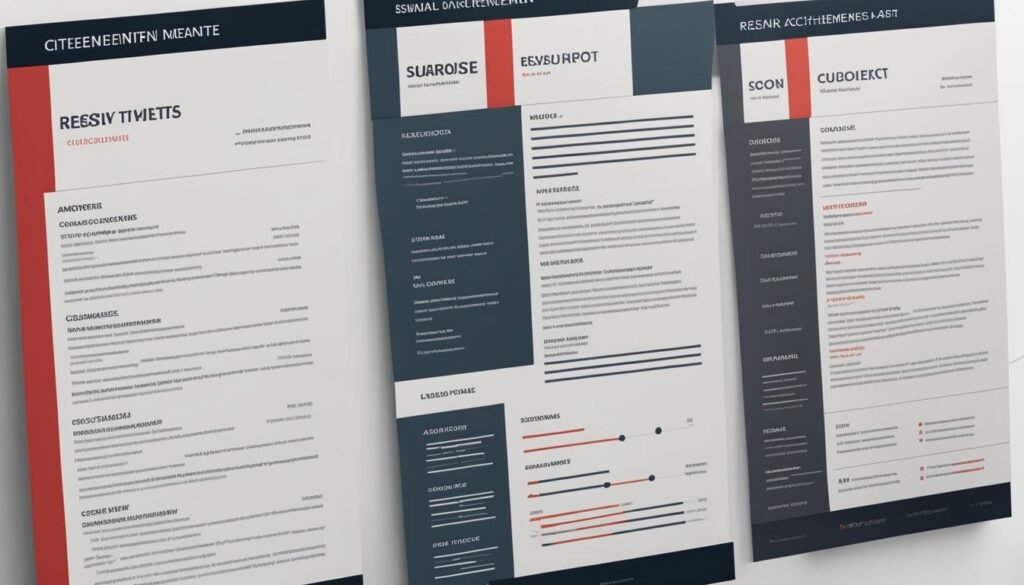When it comes to crafting a standout resume, the right formatting and content can make all the difference in catching the attention of potential employers. By following these tips, you can ensure that your resume is well-structured, visually appealing, and effectively portrays your skills and qualifications.
To create a winning resume, it’s essential to pay attention to both the formatting and content. The formatting should be clean and professional, making it easy for employers to read and navigate. Use consistent fonts and sizes, organize information logically with headings and bullet points, and leave adequate white space to enhance readability.
When it comes to resume content, include essential sections such as your contact information, a professional summary or objective statement, your work experience, education, and relevant skills. Tailor your resume to the specific job you’re applying for, highlighting skills and experiences that align with the requirements.
Showcasing your accomplishments is also crucial in making your resume stand out. Use action verbs and specific examples to describe your achievements, demonstrating the impact you made in previous roles. Including quantifiable results, such as percentages or numbers, adds credibility and shows your ability to deliver measurable outcomes.
In the United Arab Emirates (UAE) job market, customizing your resume is essential. Consider including a professional headshot and personal information such as nationality and visa status, which are customary in the UAE. Highlight any relevant experience in the region or with multinational companies to demonstrate your understanding of the local business environment.
Another important aspect to consider is optimizing your resume with relevant keywords and phrases. Many employers use applicant tracking systems (ATS) to scan resumes. Research job postings and industry-specific terms to identify the most appropriate keywords to include in your resume, particularly in the skills and job description sections.
When submitting your resume online, it’s important to format it properly for digital submission. Saving your resume as a PDF ensures compatibility and maintains its formatting across devices. Consider adding hyperlinks to your portfolio or LinkedIn profile for easy access. Additionally, avoid fancy designs, excessive formatting, or non-standard fonts to optimize your resume for ATS.
In conclusion, with the right formatting, content, and customization, you can create a standout resume that impresses employers and increases your chances of landing your dream job. Take the time to craft a well-structured and visually appealing resume that effectively showcases your qualifications and sets you apart from the competition.
The Importance of Proper Formatting
First impressions matter, and your resume’s appearance plays a crucial role in captivating recruiters. Proper formatting is essential to make your resume visually appealing and professional, increasing your chances of standing out in the job application process. When it comes to resume formatting, consider the following:
- Use consistent font styles and sizes throughout your resume to maintain a neat and cohesive look.
- Organize your information in a clear and logical manner. Use headings, bullet points, and sections to make it easy for recruiters to skim through your resume.
- Incorporate appropriate white space to improve readability and avoid overcrowding the document. This helps highlight key details and ensures that important information doesn’t get overlooked.
By paying attention to these formatting elements, you can create a professional resume layout that enhances readability and effectively showcases your qualifications.

Essential Sections and Information to Include
When creating your resume, it’s important to include the essential sections that will capture the attention of potential employers. These sections provide a comprehensive overview of your qualifications and relevant skills. By tailoring your resume to the specific job you’re applying for and incorporating measurable achievements, you can effectively showcase your abilities and stand out from other applicants.
Contact Information: Start your resume with your full name, professional email address, and phone number. Include your LinkedIn profile or portfolio website, if applicable.
Professional Summary or Objective Statement: Craft a concise and compelling summary or objective statement that highlights your key strengths and career goals. This section provides a snapshot of your qualifications and sets the tone for the rest of your resume.
Work Experience: Detail your professional experience, starting with your most recent job. Include the company name, job title, dates of employment, and a brief description of your responsibilities and accomplishments. Focus on relevant experience that aligns with the job you’re applying for.
Education: List your educational background, starting with your most recent degree. Include the institution name, degree or certification earned, and graduation year. If you’re a recent graduate or have limited work experience, emphasize your academic achievements and relevant coursework.
Skills: Highlight your relevant skills and abilities in a separate section. This can include technical skills, software proficiency, foreign languages, or any other skills that are applicable to the job. Be sure to prioritize skills that are most sought after in your industry.
Quantifiable Achievements: Incorporate specific achievements and quantifiable results throughout your resume. This can include metrics or numbers that demonstrate your impact in previous roles. For example, “Increased sales revenue by 25% within the first quarter.”
Remember, the content of your resume should be tailored to the job you’re applying for. Review the job description and identify the skills and experiences that are most important for the role. By customizing your resume to highlight relevant skills and achievements, you can increase your chances of catching the attention of employers.
Now that you know the essential sections and information to include in your resume, let’s move on to the next section, “Showcasing Your Accomplishments,” where we’ll discuss how to effectively highlight your achievements and make your resume stand out even more.

Showcasing Your Accomplishments
When it comes to making your resume stand out, it’s essential to showcase your accomplishments and the impact you have made in your previous roles. The best way to do this is by using action verbs and specific examples to describe your achievements, highlighting measurable results and quantifiable outcomes.
For example, instead of simply stating that you were responsible for increasing sales, you could emphasize how you successfully increased sales revenue by 20% within six months. This not only demonstrates your ability to achieve quantifiable results but also provides concrete evidence of your success.
When describing your accomplishments, focus on the specific actions you took and the results you achieved. Did you implement a new process that improved efficiency? Did you lead a team that successfully completed a project ahead of schedule? These are the types of accomplishments that will capture the attention of employers and set you apart from other candidates.

Remember, your resume is an opportunity to showcase your skills and qualifications, so don’t be shy about highlighting your achievements. By providing quantifiable results and emphasizing the impact you have made, you can demonstrate your value as a candidate and increase your chances of landing your dream job.
Tailoring Your Resume for the UAE Job Market
When applying for jobs in the United Arab Emirates (UAE), it’s crucial to customize your resume to meet local preferences and requirements. To increase your chances of standing out in the competitive job market, consider implementing the following CV tips and resume customization techniques:
- Include a Professional Headshot: In the UAE, it is customary to include a professional headshot on your resume. A professional photograph helps create a personal connection and makes your application more memorable to hiring managers.
- Provide Personal Information: Along with your contact details, consider adding your nationality and visa status to your resume. Including this information is common practice in the UAE and helps employers understand your eligibility to work in the country.
- Highlight Relevant Experience: Emphasize any experience you have working in the UAE or with multinational companies. Highlighting your familiarity with the UAE business culture and industry-specific knowledge can make your resume more appealing to employers.
By tailoring your resume to the UAE job market, you can demonstrate your understanding of local requirements and increase your chances of securing an interview. Remember to use a professional headshot, provide relevant personal information, and showcase your experience in the region or with multinational companies.

Optimizing Keywords and Phrases
When it comes to impressing potential employers with your resume, incorporating relevant keywords and phrases is crucial. Many companies utilize applicant tracking systems (ATS) to scan resumes for specific keywords and filter out applicants who don’t meet their criteria. To increase your chances of getting past the initial screening, it’s vital to optimize your resume with the right resume keywords and create an ATS-friendly resume.
To identify the most appropriate resume keywords, start by researching job postings in your desired industry. Look for recurring terms and skills that are commonly mentioned. For example, if you’re applying for a marketing role, keywords such as “digital marketing,” “social media management,” and “SEO optimization” might be relevant.
It’s important to strategically incorporate these keywords throughout your resume, especially in the skills and job description sections. Be sure to use them naturally and thoughtfully, avoiding keyword stuffing, which can be off-putting to both human readers and ATS.
Additionally, consider using industry-specific terminology and jargon when relevant. This shows your familiarity with the field and can help your resume stand out among others. However, always ensure that you provide clear and concise explanations of any technical terms or acronyms used.
To further increase your chances, tailor your resume keywords and phrases to match the specific requirements of each job application. Analyze the job description and highlight the skills and qualifications that align with the position. By customizing your resume, you demonstrate a genuine interest in the role and make it easier for employers to identify your suitability.
Creating an ATS-friendly resume is crucial because it ensures that your application is read by hiring managers. Follow these tips to optimize your resume:
- Choose a clean and simple resume format: Avoid complex designs, excessive formatting, or non-standard fonts that may not be compatible with ATS.
- Use standard section headings: Stick to commonly used headings such as “Work Experience,” “Education,” and “Skills” to make it easier for the ATS to categorize your information.
- Include relevant keywords and phrases: Incorporate specific industry keywords and phrases that align with the job description.
- Format dates consistently: Use a standard date format (e.g., MM/YYYY) to ensure the ATS can accurately interpret your work history.
- Keep it simple: Avoid using graphics, tables, or charts that may not be parsed correctly by the ATS.
- Proofread your resume: Carefully review your resume for any spelling or grammatical errors that could affect the accuracy of keyword recognition.
By optimizing your resume with relevant keywords and creating an ATS-friendly format, you’ll increase the likelihood of your application being noticed by potential employers. Remember, balance is key—strategically incorporate keywords while maintaining a clear, concise, and visually appealing resume.
Formatting Tips for Online Submissions
In today’s digital age, the majority of resumes are submitted online or via email. To ensure your digital resume stands out, follow these formatting tips:
- Save your resume as a PDF: When submitting your resume online, save it as a PDF file. This format ensures compatibility and maintains the formatting of your resume across different devices.
- Use Hyperlinks: Consider adding hyperlinks to your portfolio or LinkedIn profile within your resume. This allows potential employers to easily navigate to additional information about you and your work.
- Optimize for ATS: Applicant Tracking Systems (ATS) are commonly used by employers to scan resumes for keywords and phrases. To increase your chances of getting through the initial screening, avoid excessive formatting, fancy designs, or non-standard fonts that may be difficult for ATS to read.
By following these formatting tips, you can ensure that your online resume is professional, easily accessible, and optimized for potential employers and ATS systems alike.
Conclusion
Crafting a winning CV requires attention to detail and strategic planning. By implementing the resume tips provided in this article, you can create a standout resume that effectively showcases your qualifications and sets you apart from the competition.
Remember to proofread your resume for any errors or inconsistencies to ensure it presents a professional image. Customizing your resume for each job application is essential, as it allows you to highlight your relevant skills and experiences that align with the specific job requirements.
With a well-crafted and visually appealing resume, you’ll be one step closer to landing your dream job in the United Arab Emirates. Take the time to carefully tailor your CV, making it a powerful tool that impresses employers and maximizes your chances of success. Good luck!


